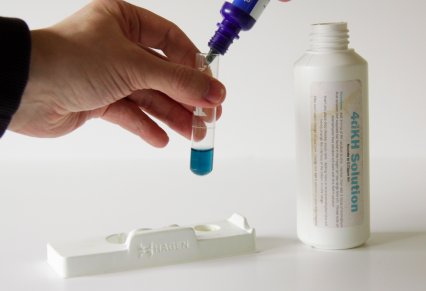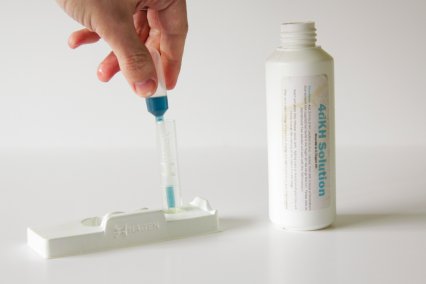George Farmer takes a look at how to measure the levels of CO2 in the planted aquarium to ensure it benefits the plants, while remaining safe for your fish.
Carbon dioxide (CO2) injection in planted aquaria has become very popular and ever more manufacturers are supplying user-friendly kits.
Carbon is the most important element for plant growth and gas injection is the most effective way to provide this nutrient. However, it is not a simple case of adding as much as possible.
This gas is highly toxic when overdosed and is probably the biggest cause of livestock fatalities in planted aquariums. It is therefore vital to test or monitor gas levels in the long-term.
Varying threshold
A CO2 content of 30 parts per million (ppm) or milligrams per litre (mg/l) is safe for most fish and inverts. However, the toxicity threshold can vary considerably, depending on dissolved oxygen (O2) levels.
In aquariums with relatively low levels of O2, the livestock will be more sensitive to the gas, but in aquariums with high levels of O2 the safe threshold limit of CO2 increases.
However, I would never go over 30ppm CO2 and aquaria with lower lighting will provide less.The pH/KH/CO2 relationship
When CO2 gas dissolves in water it creates carbonic acid. This will acidify the water and pH will decrease. This basic relationship allows us to determine approximately how much CO2 is in the water.
Another important aspect to water chemistry is carbonate hardness (KH). Also known as alkalinity, the KH represents the pH buffering capacity of the water. Harder water will have a higher buffering capacity and vice versa.

The intrinsic relationship between CO2, pH and KH is known and can be found in the table above. Use it to test your pH.
Let’s say it’s pH 6.6. Test your KH. It measures 4° (4 KH). Look at the table at the pH and KH, and see where they intersect. This is the CO2 level — in this case 30ppm.
However, we may misread our test kits, or they may be inaccurate. Liquid pH test kits rely on interpreting a colour chart and KH test kits rely on counting the amount of test kit liquid drops it takes to change the colour of the aquarium water in the test tube.
If either parameter is misread or inaccurate by as little as 0.2 pH or 0.5 KH it can mean under or over readings.
It’s possible to think you are reading 30ppm CO2, but it could be as much as 45ppm or higher and lethal to fish.
Another factor can throw CO2 accuracy. The pH/KH/CO2 relationship assumes that carbonic acid from CO2 is the only acidifying compound, but this is not the case for most of us.
Nitric acids, humic acids and other organic matter will all contribute to acidification of aquarium water. This will typically result in pH readings lower than the table assumes — resulting in a false CO2 calculation.
Drop checkers
Long-term gas monitoring has been around for many years and is arguably a much more accurate and convenient method for testing levels. The most common method is via drop checkers, which work by sitting inside the aquarium water.
These are filled with a solution of water and pH reagent known as bromothymol blue. This is the pH test kit reagent supplied with low-range pH test kits (pH 6.0 to pH 7.6). Wide-range pH test kits are not suitable.
As the gas in the water reacts with the bromo blue/water solution it changes solution colour, ranging from a dark blue, which is a high pH/low CO2, through to a yellow, which is low pH/high CO2.
The best way to use a drop checker is to fill it with water of a known water chemistry. In our case, water with a KH of 4° (4KH) is perfect. This 4 KH reference solution allows us to monitor CO2 levels more accurately.
Using a low-range pH test kit notice the lime green of pH 6.6 on the chart. We know by using the pH/KH/CO2 table that pH 6.6 with 4 KH gives us 30ppm CO2.

So by aiming for that specific lime green in our drop checker we are aiming for 30ppm CO2.

Any more blue than that lime green and there’s less than 30ppm CO2.

More yellow means more than 30ppm CO2.
Because the reference 4 KH solution in our drop checker is separated from our aquarium water via an air gap, the only influence on its pH is via CO2. This principle makes it more accurate and potentially safer than using the pH/KH/CO2 table and test kits.
There are disadvantages to this method. The solution inside the drop checker can take several hours to change colour, so potentially misleading us into thinking that more gas is required. The larger the air gap between the aquarium water and the drop checker solution, and the more solution volume there is, the more time it will take.
It also requires comparison to a colour chart, which can lead to misinterpretation. Be cautious and obtain a darker green rather than a yellow/green colour. In very large aquariums it’s not uncommon to use multiple drop checkers to ensure the CO2 is being distributed effectively around the aquarium.
Move your drop checker around to determine your gas levels at all parts of your aquarium, especially in high-energy systems that require CO2 levels to be spot on.
Lower CO2 testing
If you have a low-energy planted aquarium, such as low lighting and nutrient levels, then 30ppm CO2 is not necessary. The plants will be happy with such as 15ppm and this presents less risk to fish.
To easily measure this with a drop checker just dilute the 4 KH solution with 50% RO water. This makes it 2 KH and at 15ppm the drop checker will be at the desired lime green colour. Cross refer to pH 6.6 on your low-range pH test kit colour chart.

Gas intoxication
One of the best indicators of overdosing is to keep a close eye on your fish. Early symptoms include sluggish behaviour and loss of appetite. More severe symptoms will include gasping at the surface and unconsciousness.
In such circumstances the most efficient way to reduce CO2 levels is to perform a large water change as soon as possible. Ensure the new water is approximately the same temperature and de-chlorinated to limit further stress.
Agitating the surface by moving your filter outlet or adding an air stone will help, but these are not as effective as a rapid water change. The most likely time fish will incur gas intoxication is through the dark period when the plants respire and produce CO2 and use oxygen.
For this reason have the CO2 injection turn off just before the lights extinguish. Many hobbyists choose to have their gas come on an hour or so prior to lighting. This enables levels to build up so the plants can begin photosynthesis earlier in the photoperiod.
Some pressurised CO2 kits will dump a large amount of gas into the aquarium just before the cylinder empties. Change the cylinder before it reaches such a low level.

Drop checker types
There are glass or plastic types of all shapes and sizes, but they all use the same principle of holding a small volume of pH reagent/water solution that changes colour, depending on CO2 levels.
Some drop checker instructions advise using aquarium water but, due to the huge variation in potential readings, if you have aquarium water with a KH of 10 it will take a lot more than 30ppm CO2 to move the colour into the green range.
Dennerle and Cal Aqua supply a reference pH/KH solution ideal for adding straight into your drop checker, but it’s quite simple to make up your own reference pH/KH solutions.
Buy a low-range pH test kit, and Nutrafin and API are two well-known brands, or you can buy bromothymol blue. I recommend buying a kit so you have the colour chart required to compare your drop checker colour with the pH 6.6 green indicated.
You can either buy a ready-mixed 4KH reference solution, or make your own. Do so by adding 0.12 grams of baking soda and 1 l/1.8 pints of distilled water.
pH controllers
These work using the principle that gas levels are linked to the aquarium water pH. A solenoid linked to a pH probe will turn the CO2 on and off, depending on a preset pH value determined by the aquarium water KH and by using the table.
As mentioned earlier, CO2 is not the only factor to change pH levels. Due to the nature of most pH controllers the gas is turned on and off many times during a 24-hour photoperiod using a solenoid. You can also have the solenoid linked to the lights so CO2 is not wasted during darkness.
The biggest potential issue with pH controllers is that they produce unstable CO2 levels commonly attributed to algae issues. They are also relatively expensive and the pH probe needs regular calibration. If the probe fails it’s possible for the CO2 to remain on continually, causing an overdose.
Did you know?
In a high-energy planted aquarium with good light and regular nutrient dosing, the biggest cause of algae is poor or fluctuating CO2 levels.
Rapidly growing plants depend on a stable source of carbon enrichment and adapt to conditions provided. If this source fluctuates or drops off during the photosynthetic process the plant will suffer and trigger algae growth.
Dosing a liquid carbon fertiliser in conjunction with gas injection can help to address any carbon shortfall, but in the long term it’s better to provide an appropriate level of CO2 injection.
In lower-energy systems, such as low lighting, injection can be replaced by liquid carbon dosing.
How to use a 4 KH CO2 drop checker

1. Get a drop checker, low-range pH test kit or bromothymol blue pH reagent, 4 KH reference solution, test tube and pipette or syringe.

2. Using the pipette or syringe add 4 KH solution to the test tube. Don’t fill to the line, as only a tiny amount is needed for the drop checker.

3. Add two drops of the bromo blue pH reagent to the 4 KH solution in the test tube. Note that its blue as no CO2 is present.

4. Then using the pipette or syringe once more, draw the solution out of the test tube.

5. Add the solution to the drop checker, using the pipette or syringe.

6. The drop checker is ready to be fitted. This model hangs on the side of the glass with the open end inside the water.








